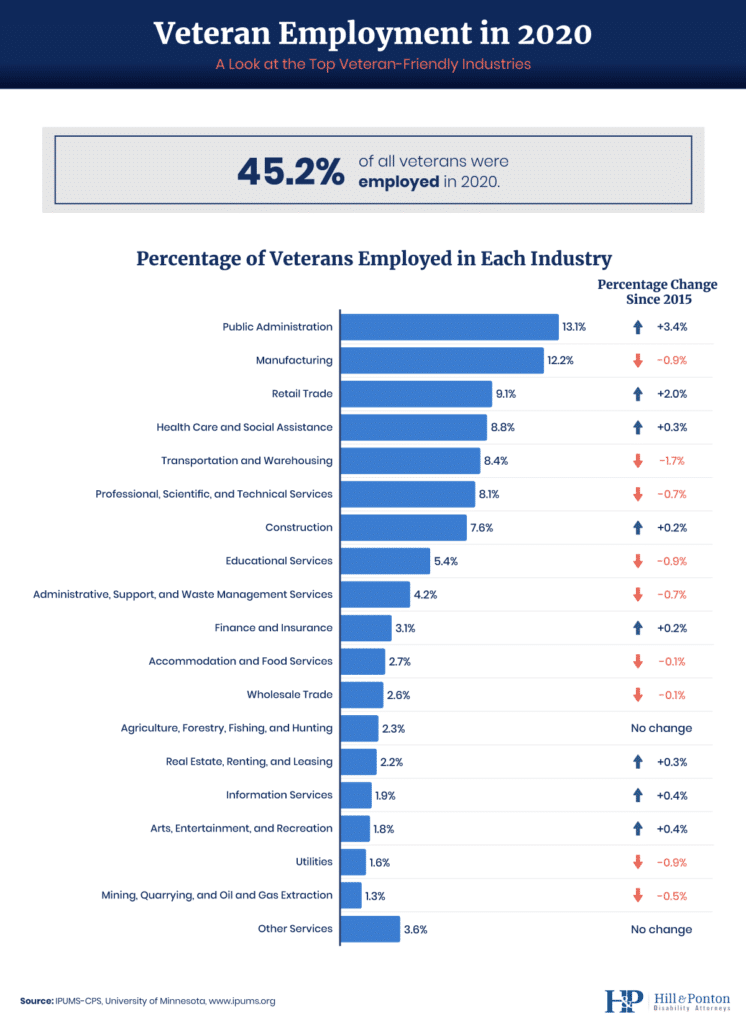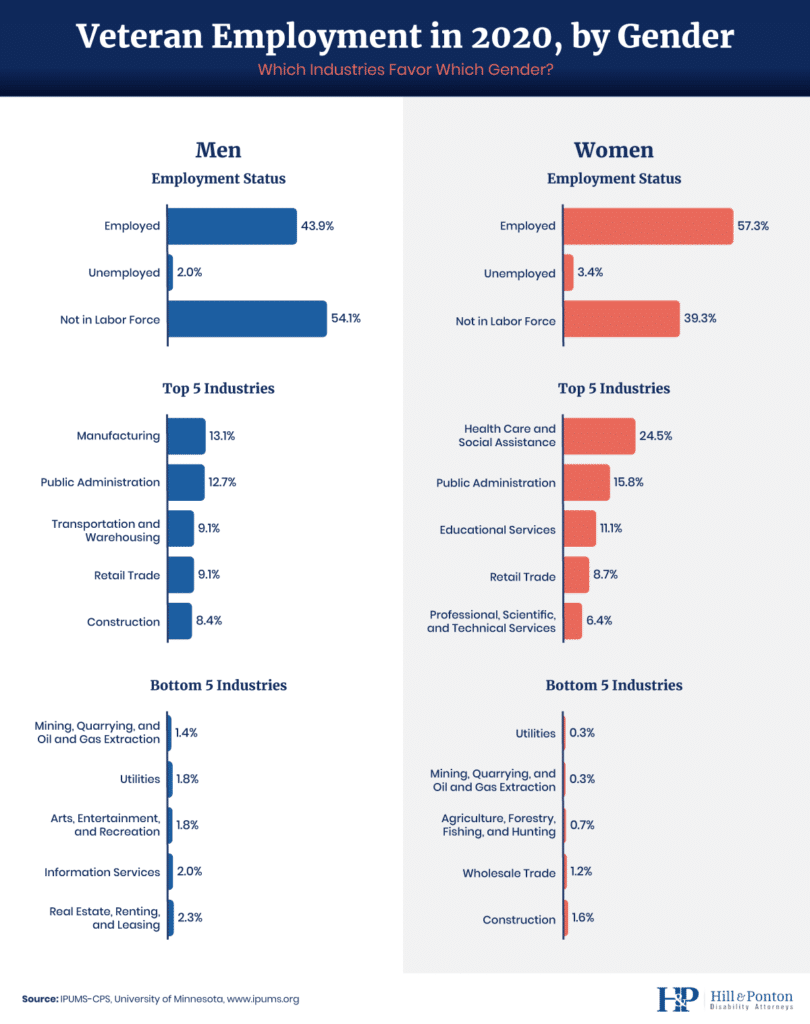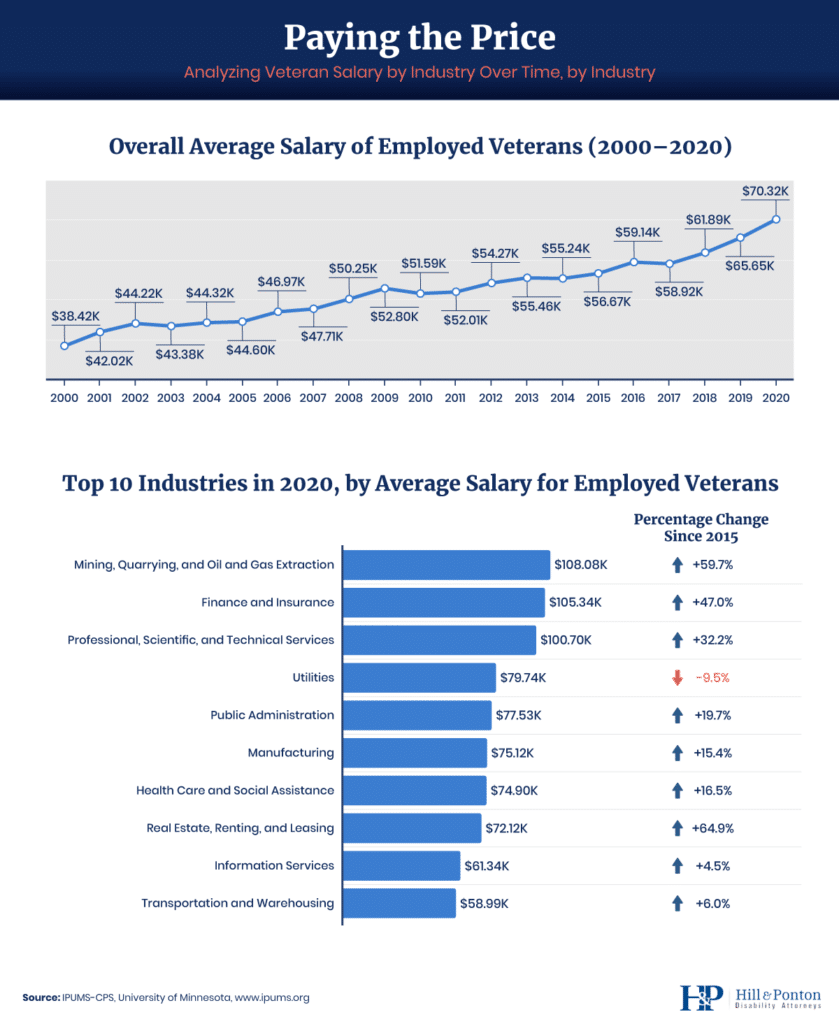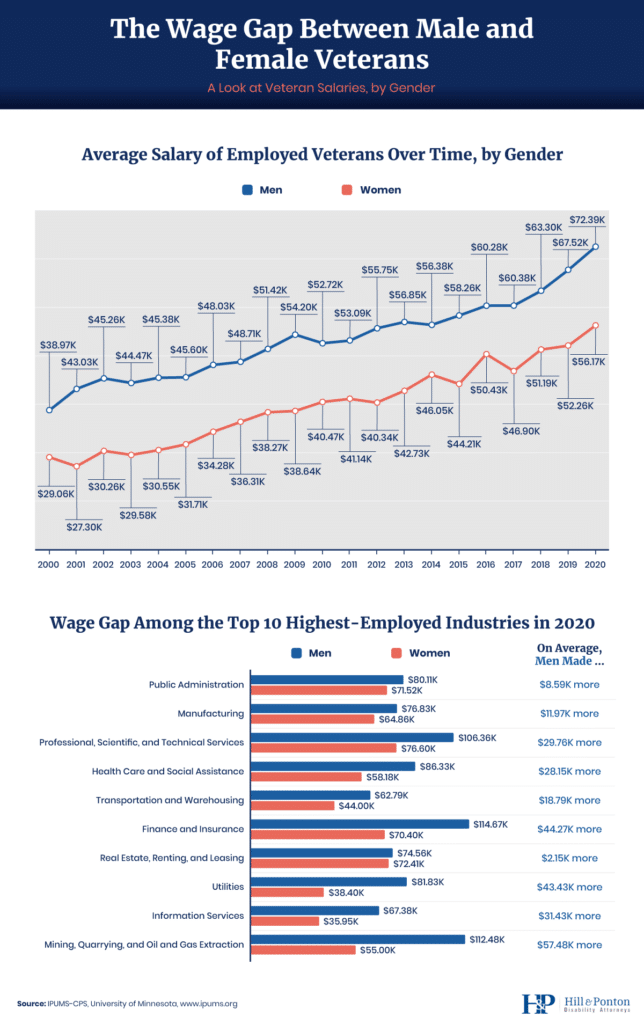
For many of our country’s heroes, finding work after their service is the next mission. Luckily, there are programs that can help guide them into the next chapter of their life. When transitioning back into civilian life, 7.1% of veterans made contact with a state employment specialist for assistance in finding a job or obtaining job-related training since leaving active duty. Of these, 69.2% found the help useful.
We’ll be taking a more in-depth look into the types of industries veterans are working in, how their salaries have changed over the years, breaking down the differences between genders, and looking into other veteran-related information that may provide further insight into their transition from service to civilian.
Veterans in 2020: Where Are They Working?
In 2020, 45.2% of all veterans were recorded to have been employed in some capacity. Working in public administration or manufacturing were the most popular jobs for veterans, coming in at 13.1% and 12.2% of veteran employment, respectively. Whereas all other jobs have seen a fluctuation of 2% or less since 2015, public administration representation had increased by 3.4%.

There are a few reasons why working in the public sector might be an attractive option for veterans. Stemming from their desire to serve their countries, veterans will have amassed a lot of transferable skills from their time on duty. Some of these include strong leadership, problem-solving skills, and their heightened understanding of how law, policy, and government spheres intersect with one another.
Similarly, manufacturing jobs can be deemed desirable as well. Workers need to have strong attention to detail and execute with precision, something that veterans know all about. Also, the importance of teamwork is crucial, and the feeling of working together as a cohesive unit is a comfortable and attractive mindset for many veterans
Veteran Comparison by Gender and Industry
The male veteran employment rate in 2020 was 43.9%, 2% were unemployed, and the remainder were not in the labor force. On the other hand, 57.3% of female veterans were working, 3.4% were unemployed, and just under 40% were not looking for work. These numbers may be due to the fact that 27.1% of veterans with a service-related disability felt it had prevented them from getting and/or holding a job.

For those employed, though, public administration was one of the top options for either gender. Manufacturing took the top spot for men, whereas health care and social assistance was very sought after by women. In the U.S., the largest health care occupation is registered nurses with over 2.4 million workers and another 1.2 million nursing, psychiatric, and home health aides. Over 85% of these workers are made up of women. Veteran or not, women in general are the majority in this industry.
Both genders were represented the least in the mining, quarrying, and oil and gas extraction industries as well as the utilities industry. The low participation rate could be attributed to the fact that these industries involve a lot of physical labor. Just over 25% of employed veterans were exposed to combat during their service. Of the 19.6% of veterans with a service-connected disability, 18.2% of employed veterans had one. Therefore, these industries might be unrealistic options for many of them and could be generally undesirable due to the health risks of working these kinds of jobs.
Salary and Industry Increase
Over the last 20 years, the overall average salary of employed veterans has steadily increased. In 2000, it was $38,420 and hit $70,320 this year. Interestingly enough, the least desirable industries, being resource extraction and utilities, claimed two spots out of the top 10 average salaries for employed veterans – they are $108,080 (highest) and $79,740 (fourth highest), respectively.

Since 2015, and aside from the utilities sector, all of the top ten industries have shown a healthy increase in average salaries. The highest jump has been in real estate, rental, and leasing with a growth of 64.9%. This increase could be attributed to this particular sector’s market growth over the last five years; it has seen a 2% annualized revenue increase and has eclipsed a market size of over $1 trillion.
The Reality of the Wage Gap
When comparing genders, there is a clear wage gap that has formed over the last 20 years. As opposed to men’s average salaries of $38,970 in 2000 and $72,390 in 2020, women’s were much lower – $27,300 in 2000 and $56,170 in 2020. The average gap between genders had also increased from $11,670 in 2000 to $20,130 in 2020.

In all of the top 10 highest-employed industries this year, a wage gap presented itself in men’s favor. The biggest difference was in the mining, quarrying, and oil and gas extraction sector – men made, on average, $57,480 more than women. Only the real estate and rental and leasing sector had a minimal difference – men made, on average, $2,150 more than women.
Regardless of being a veteran or civilian, the wage gap exists across all industries. When analyzing U.S. Census Bureau data from 2018, it was discovered that women, on average, earned 82 cents for every dollar earned by men. This was calculated by comparing the median annual earnings of full-time working women to their male counterparts. There are many factors that may contribute to the wage gap, and some are harder to measure than others. For example, an unconscious bias and discrimination against women may be at play, including the belief that women might need to leave the workforce when having children, thus deserving less compensation than men. Research also shows that women work more lower paying jobs than men, and are still underrepresented in high paying careers, namely in the C-Suite.
The Next Step
For veterans, their skills can help them transition to a new job with confidence. Many enter public administration, manufacturing and the health sector. A veteran carries the tools they’ve gained from their service, whether it be valuable leadership skills or a knack for teamwork, which can help propel them toward newfound success.
When comparing male and female veterans, it was apparent that neither were highly represented in dangerous and labor-intensive industries. Many veterans, especially those with combat experience, may be physically unequipped or emotionally unprepared to work in these conditions – or, unfortunately, in any at all.
The wage gap also exists between male and female veterans, as it does throughout all industries and workers. Although the gap has narrowed, there is still work to be done to achieve true income equality. When it comes to the leap from service to civilian, veterans deserve to be treated as equals too.
Methodology and Limitations
Data for this study were mined from the IPUMS-CPS database, particularly 2000 to 2020 ASEC. The data was filtered by Veteran Status, ensuring that only veterans were used. The data included various categorical variables including: Gender, Employment Status, Industry of Employment, and Wage/Salary Income. Industry values were decoded and grouped based on the IPUMS-USA industry code breakdowns. Each year of ASEC data was compressed into one main spreadsheet containing the above variables along with the respective year of the data point.
The limitations of this study include the following: The IPUMS database is entirely composed of sample data and a lack of geographic information, which is a potential confounder of salary data.
Fair Use Statement
Help get veterans the recognition they deserve. We encourage you to share our findings and ask that you only do so for noncommercial use. Also, please provide a link back to the article page so the study’s contributors can earn credit for their work.




